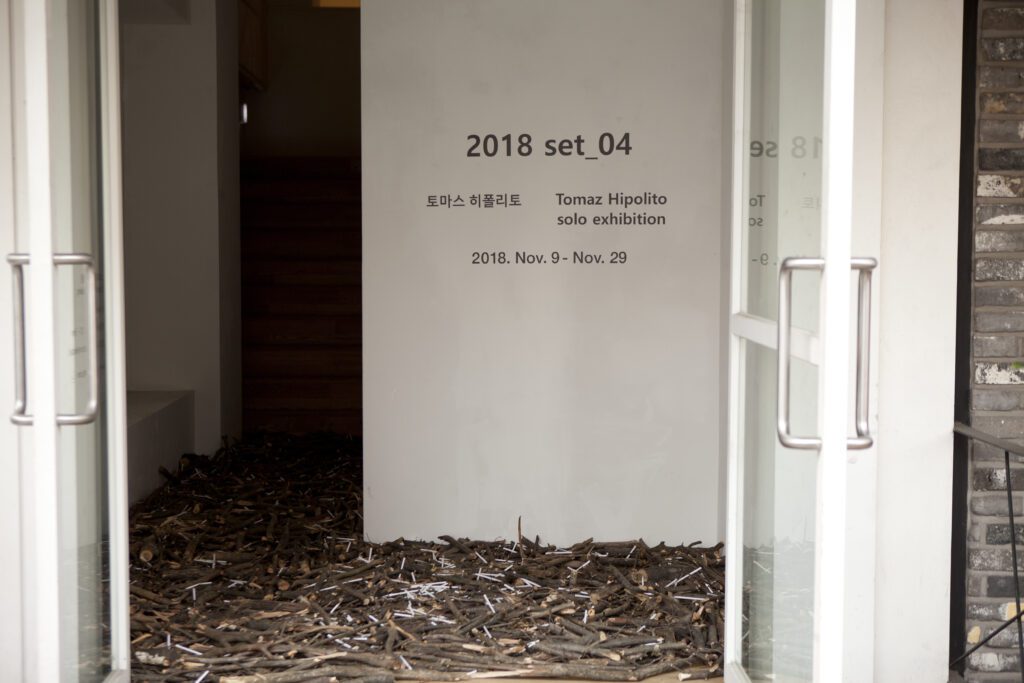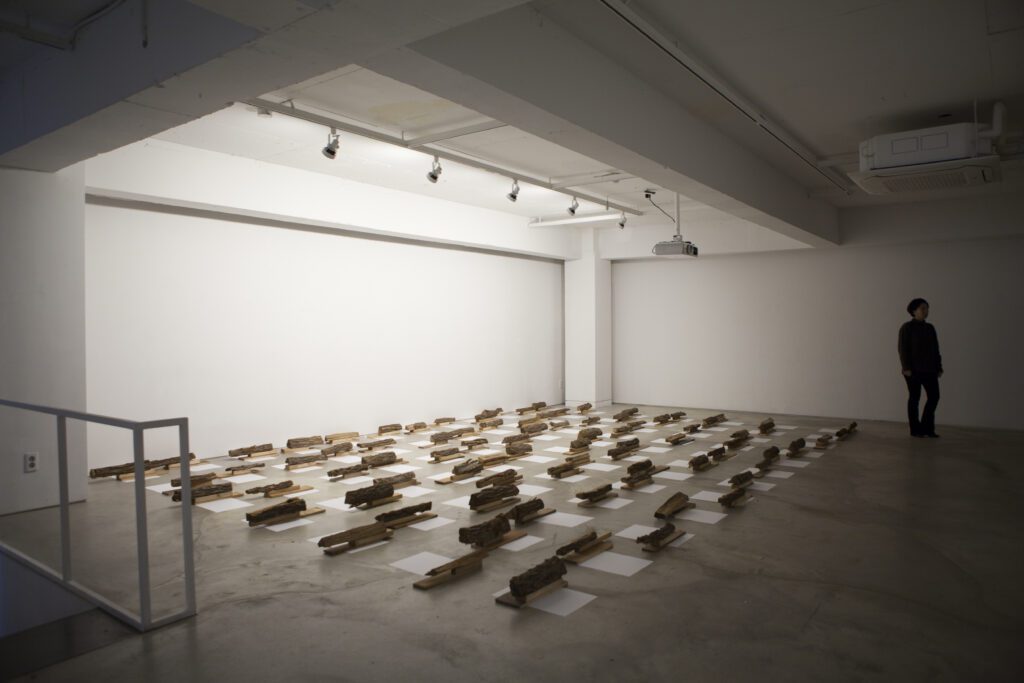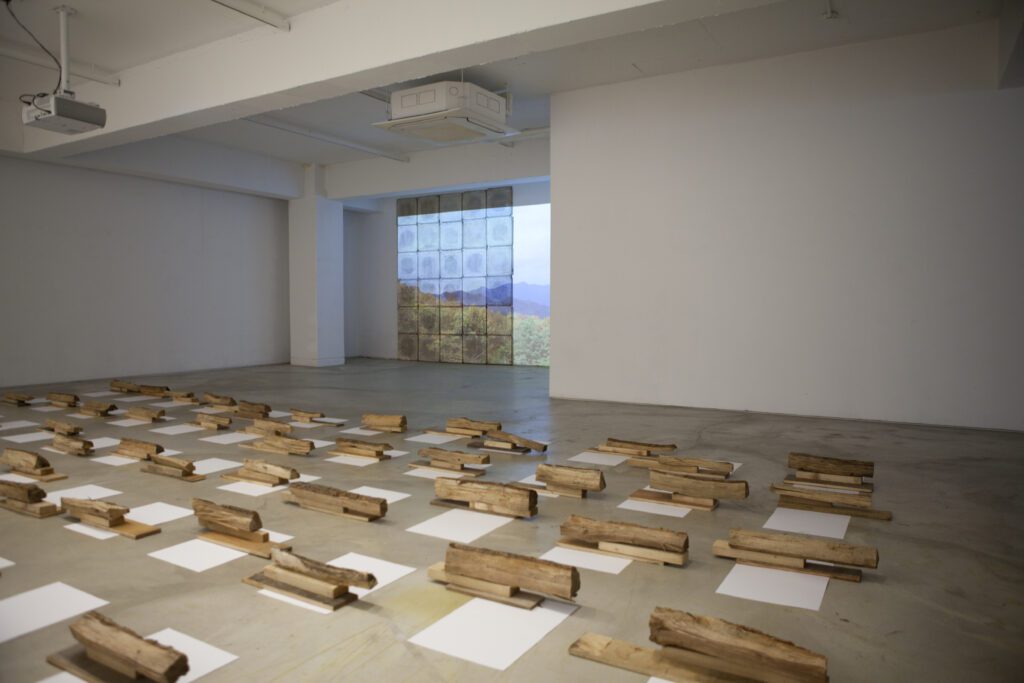2018 set_04
project projectThe immersion on paper, using trained and random gestures crossing several drawing practices,
will allow to unfold different levels of relationship between medium and content.
Some will be visible thru revisiting the process, and some will be visible from end result.
All paper is available to be drawn. Every drawing is ready to become a gesture.
It is true that one might find it difficult to immediately understand the meaning of Tomaz Hipólito’s works. As he has mentioned, “My work is not meant to produce meaning,” his works work in a different way from the art works in the traditional sense. The title of the exhibition also works like an index, and it does not have any meaning individually. The artist’s homepage (www.tomzahipolito.net) has faithfully archived various series of works that he has been working on. Titles of his exhibitions are consisted of 1) the year in which each exhibition was held and work was created, 2) the names of the seriessuchas set, persona, meat, paper, merge, object, map, diorama draw, and 3) series number. In other words, his works can be understood better if you have an access to his previous works.
The title of the exhibition which was held at Space: Willing N Dealing in 2018 is <2018 set_04>. <set> is a name when two or more previous series are combined. Since he combined <paper> and <merge> series, He used the name <set> for this exhibition. The <paper> series literally means he makes something by using paper, and the <merge> series means creating multiple layers using different materials. This exhibition <2018 set_04>, which combines these two series, shows several different layers by making use of paper.
Hipólito, who had no specific plan for this exhibition until he came to Korea, other than to use paper and to make use of his own body as a tool, explores the surrounding environment and reacts to it. His unique ‘gesture’ intervenes and transforms into space in his work. He always works with the space including the whole environment, and his own body that recognizes and accepts it. That is why Hipólito constantly devotes himself in producing new works wherever he stays. Although they are not publicly available, there are several series of works that have been created while he stayed in the Gyeonggi Creation Center in 2015 for three months. His works are all created in relationship with the surrounding environment, including the Daebu Island.
Tomaz Hipólito opened his studio in Portugal as an open residency and has created a system that allows various artists around the world to stay there from one month to six months. He not only constructs but also utilizes the international network. A Korean artist, Lee Hunchung, who is working on pottery stayed at Hipólito’s residency, invited Hipólito to stay in his Yangpyeong atelier and prepare for the exhibition at Willing N Dealing.
Having stayed in Yangpyeong, Hipólito was deeply fascinated by the autumn scenery of Korea, which is very different from Portugal. He enjoyed the autumn mood through the mountains and fields every day, following the red, yellow, green, and brown colors created by nature. He came to Korea with a plan to make new works using paper, and he decided to make this exhibition using the materials he discovered in Yangpyeong and the sense he felt there.
In order to enter the exhibition space, every visitor had to go through a passage full of twigs and paper straws. As if you were walking in the woods, all the visitors would feel a kind of inconvenience walking in nature, not in artificial well-laid roads and building spaces. In addition to the branches picked up directly from the forests, a thin straw made of paper was placed in the entrance to the exhibition space, which was made from the same material, the wood. If you come up to the exhibition space along the stairs, you can feel the natural more. Hipólito piled up pieces of tree that has been transformed in various ways such as real wood with the bark and texture of the tree remaining intact, trimmed wood, plywood and paper. He treats space like a paper, a tree as a pencil, and makes drawings within the space. Yellowish light is shed on one side, and the shadow is made naturally, and the view is different according to the direction in which the viewer sees. The audience will ‘experience’ the tree-drawing in his/her own way.
On the other side of the wall, a set of photos edited in a video work <Árvores/Trees> were photographed with a paper on a real tree. Hipólito actually went into the woods and put a piece of white paper between the gaps in the trees temporarily. The paper, which was pinched between the trees, was placed in that position as if it were at any moment can be blown by the wind. On the innermost wall of the exhibition space, <layer> was projected. A video of maple forest from Yangpyeong Studio looks like a still image, but it is actually a video with slight motions. If you have a sharp eye, you can see that this is not a picture by the fine movements of the clouds. About half of the video projections area, wooden pedestals used by Lee Hunchung’s pottery works were hanged on the wall. It is another object made of wood.
On the day of opening reception, Hipólito showed a performance. It was a performance that puts paper on top of the projected image, and wooden pedestals. Wearing all in black, Hipólito wet the A4 sized paper in the water and put it on the wall. Thanks to the white paper, the scenery of the background becomes clearer, and when the water evaporates over time, the paper falls back to the ground like a fallen leaf.
Hipólito uses various materials made of wood to make works. He reconstructs the exhibition space with products made from wood, such as paper, plywood, and paper straw. Scenes of nature is brought into the exhibition space using media such as photographs and images, and he attempts to directly intervene in it. All of these can be experienced each viewer in his/her own way. Instead of trying to make a fixed creation from the beginning to the end, Hipólito uses the ready-made objects available in his surroundings to intervene in the space and reconstruct it as he experienced. This exhibition gives an opportunity for us to see our surroundings, which we regarded as ordinary and plain with a unique wit and novel imagination.
Choi Jeongyoon






































